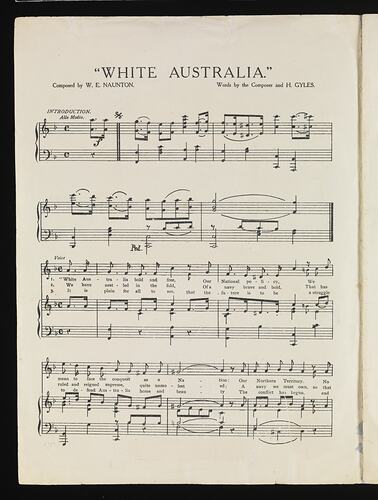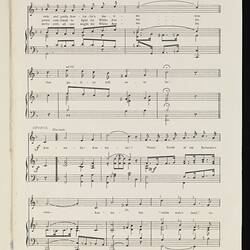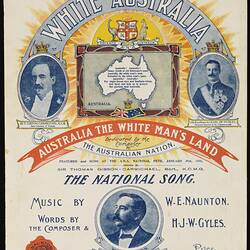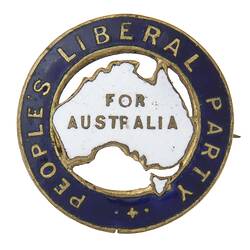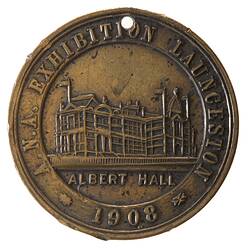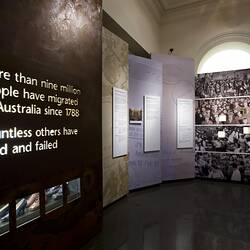Summary
Note: This object includes white superiority messaging and derogatory references to non-white cultural groups. Such depictions are not condoned by Museums Victoria which considers them to be racist. Historical distance and context do not excuse or erase this fact.
Sheet music for the 'White Australia' song, composed by W.E. Naunton with words by Naunton and H.J.W. Gyles, and performed at the Australian Natives' Association National Fete, 31 January 1910. The song consists of three verses and a chorus. Motifs on the sheet music include a white map of Australia. Naunton was a prolific composer who wrote music for many songs relating to Australian nationalism and other subjects. Naunton's College of Music was located at 145 Collins Steet, Melbourne. The sheet music was published by A.M. Dinsdale,105-107 Bourke Street, Melbourne.
Description of Content
6 page sheet music, with central spine fold and 1 loose central page. Cream paper with illustrated front cover in primarily blue, red and yellow titled: 'THE GREAT NATIONAL POLICY SONG. WHITE AUSTRALIA. AUSTRALIA THE WHITE MAN'S LAND. THE NATIONAL SONG.' Includes Commonwealth of Australia coat of arms with words 'ADVANCE AUSTRALIA ANA' underneath; white map of Australia with song chorus; images of Sir T. Gibson-Carmichael, K.C.B, State Governor of Victoria, His Excellency the Earl of Dudley, Governor-General of the Commonwealth and W.E.Naunton the composer. The cover also states that the song was 'featured and sung at the ANA National Fete, January 31st, 1910.' Published by A.M. Dinsdale,105-107 Bourke Street Melbourne. Inside pages contain music and lyrics for 'White Australia', composed by W.E. Naunton and words by composer and H. Gyles. The song consists of 3 verses and a chorus. Rear cover
Physical Description
Six-page sheet music, with central spine fold and one loose central page. Cream paper with illustrated front cover in primarily blue, red and yellow. Includes Commonwealth of Australia coat of arms with words 'ADVANCE AUSTRALIA ANA' underneath; white map of Australia with song chorus; and images of Sir T. Gibson-Carmichael, K.C.B, State Governor of Victoria, His Excellency the Earl of Dudley, Governor-General of the Commonwealth and W.E.Naunton the composer. Inside pages contain music and lyrics for 'White Australia'. Rear cover features advertisement for 'the Keyboard System of Music' by W.E. Naunton.
Significance
This sheet music is an example of the popular promotion of the White Australia sentiment which dominated Australian immigration policy after Federation and which was promoted by organisations such as the Australian Natives Association. It is also critical to note that this White Australia ideology completely failed to recognise First Peoples' rights and sovereignty and any legitimacy to be included in citizenship rights. It includes white superiority messaging and derogatory references to non-white cultural groups.
The Australian Natives' Association was established in Melbourne in 1871 as a non-partisan and non-sectarian friendly society for Australian-born, white men seeking to shape Australia's nationhood and identity. The ANA was a strong advocate for Federation and became an advocate for White Australia. It was a staunch supporter of trade protection and immigration restriction, and Prime Minister Alfred Deakin was a member. The song espouses nationalistic propaganda, referencing the White Australia policy, anti 'non-white' immigration, the importance of a national naval defence force and a version of the common Federation phrase 'One People, One Destiny, One Nation' - 'One flag, one tongue, one people's destination.' The featuring of the Victorian Governor and Commonwealth Governor-General on the cover gives the publication an official seal of approval; while the use of the white map of Australia iconography, a common feature of medals and stamps, reinforces the white Australia message. A copy is also held by the National Library of Australia (slightly different in that the header reads: 'March of the Great White Policy').
The newly federated Australian government quickly introduced national legislation to protect its security and assert its sense of identity as a member of the British Empire. One of the first acts passed was the Immigration Restriction Act - known as the White Australia policy. The Immigration Restriction Act restricted the entry of non-Europeans by means of a dictation test, which could be given in languages other than English. People suffering physical or mental diseases, convicted criminals, prostitutes and those reliant on charity, were also refused entry. From 1901 the Australian Government passed other legislation which marked out the racial boundaries of the nation. The Pacific Islands Labourers Act, 1901, enabled the deportation of over 9,000 Pacific Islander labourers who had been working in the sugar cane fields of Queensland and northern New South Wales. In 1903, the Commonwealth Naturalisation Act excluded all non-Europeans from becoming naturalised, and severely restricted their ability to bring spouses and children to Australia.
The ideal of the white, egalitarian Australian became increasingly widespread around the time of Federation. Publications such as the Bulletin, and organisations such as the Australian Natives' Association, fostered this identity, contrasting it with Great Britain's 'old world', class-based society. Yet Australian nationalism and loyalty to the Empire went hand-in-hand. Australia's involvement in World War I helped strengthen national pride. At the same time Aboriginal people were being omitted from definitions of national identity and citizenship. Ideas about racial superiority dominated the development of policy. Unions had long argued against the influx of immigrant workers, particularly Chinese, fearing an erosion of jobs and pay. The Labor Party won control of the House of Representatives in 1910 after an election run on an explicitly racist platform. Prime Minister Edmund Barton stated in 1902 that 'We can bring in, without delay, our kinsmen from Britain and, if the numbers be insufficient, such other white races as will assimilate with our own. Or we can.see the doors of our house forced, and streams of people from the lands where there is hardly standing room pour in and submerge us.'
The Immigration Restriction Act was not universally accepted. Federal parliamentarian Senator Pulsford of the Free Trade Party argued against it, although he was isolated in his stance. Beyond parliament, the Chinese community continued to voice opposition to immigration and economic restrictions. The Pacific Islands community mounted a political campaign to oppose their deportation, supported by the sugar cane farmers who employed them. The Pastoralists' Review suggested that 'responsible men are seriously talking of a Civil War rather than submit to the expulsion of the kanakas [Pacific Islanders]'. The White Australia policy also attracted international opposition. India boycotted Australian produce. China appointed its first Consul-General to Australia in 1909 to support the local Chinese community. The Japanese Government protested that the Dictation Test was conducted in 'any European language'. In response the Australian Government allowed the dictation test to be conducted in 'any language'. (Text adapted from Getting In exhibition text, 2003)
More Information
-
Collecting Areas
-
Acquisition Information
Purchase
-
Composer
W. E. Naunton, Melbourne, Greater Melbourne, Victoria, Australia, 1910
-
Composer
H. J. W. Gyles, Melbourne, Greater Melbourne, Victoria, Australia, 1910
-
Issued By
Australian Natives' Association (ANA), Melbourne, Greater Melbourne, Victoria, Australia, 1910
-
Inscriptions
Printed on front cover: 'THE GREAT NATIONAL POLICY SONG / WHITE AUSTRALIA / ADVANCE AUSTRALIA / ANA. / Australia! Australia! / Sunny south of Old Britannia's sons, / Australia, the white man's land, / Defended by the white man's guns, / Australia! Australia! / For Anglo Saxon race and Southern Cross, / God bless and help us to protect / Our glorious land Australia. / AUSTRALIA THE WHITE MAN'S LAND / Dedicated by the / composer / to / THE AUSTRALIAN NATION / FEATURED and SUNG AT THE A.N.A. NATIONAL FETE, JANUARY 31st 1910, / SIR THOMAS GIBSON - CARMICHAEL, Bart., K.C.M.G. / THE NATIONAL SONG / MUSIC BY W.E. NAUNTON / WORDS BY / THE COMPOSER & H.J.W. GYLES / NAUNTON / MELB. / COLLEGE. / W.E. NAUNTON / Published for the Composer by / A. M. DINSDALE, / 105 - 107 BOURKE ST. MELBOURNE / This Song is published in the Keyboard System of Music invented by - W.E. NAUNTON, and obtainable at 145 Collins St. Melb.' Reverse printed in blue ink: 'A GREAT AND SUCCESSFUL AUSTRALIAN / MUSICAL INVENTION / Naunton College of Music, / 145 COLLINS STREET, MELBOURNE / Established 1904' Extensive text follows.
-
Classification
-
Category
-
Discipline
-
Type of item
-
Overall Dimensions
260 mm (Width), 360 mm (Height)
-
Overall Dimensions - Folded
350 mm (Length), 260 mm (Width)
Measurement From Conservation.
-
Keywords
White Australia Policy, Music, Making History - White Australia, Racism, Immigration Selection, Immigration Debates, Immigration Policies, Friendly Societies, National Identity, Nationalism, British Empire, Protectionism
